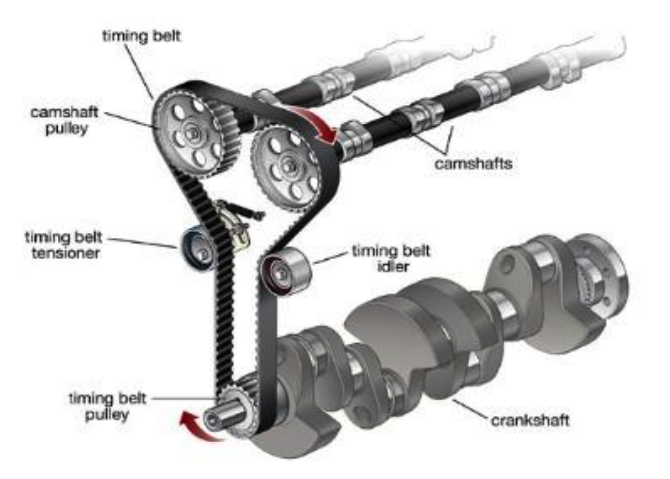Timing Belts
WHAT IS A TIMING BELT?
Many years ago, chains were employed to transmit motion between the engine crank and camshafts but these tended to be located within the engine, because a supply of oil was essential to reduce wear.
From the 1970s, many carmakers replaced their chains gradually, although some of them are now reverting, with toothed belts, called either camshaft or timing belts, which are lighter and quieter in operation. However, not only do they require routine replacement but they can also fail suddenly and without warning, unlike the old chain types, which would become noisy as they stretched and wore out.
Timing belts do not tend to snap – it is more common for the belt’s teeth to experience stress cracks at their roots, prior to becoming detached.
REPLACEMENT
The timing belt tends to operate other components, the condition of which affects the belt’s life. Excessive slack may be compensated for by one or two tensioners and idlers. Over time, their bearings may dry out, causing a squeak that should be heeded. In some cases, idlers and tensioners can seize, throwing the timing belt from its pulleys and causing extensive damage to the engine, with bent valves and even damaged pistons.
Many engines also utilize the timing belt to drive the water pump, which can also seize with the same consequences as failed tensioners.
WHEN SHOULD THE TIMING BELT BE REPLACED?
Always check your service manual for the recommend time or milage to replace the timing belt. Remember it's which ever comes first, not either or. Seek the advice and experience of a skilled technician.
Worn timing belts tend to fail at sudden engine speed changes, such as acceleration, changing gear, or revving the engine in neutral.
WHAT WILL A TIMING BELT CHANGE COST ME?
The good news is that timing belts, tensioners and even water pumps tend to be inexpensive. Unfortunately, because extensive dismantling is often required to reach these parts, the labour charge is likely to be far greater than the combined cost of the individual parts. If your car has any oil or water leaks under the timing cover, have them repaired at the same time. Crank and camshaft oil seals tend to be accessible, once the timing belt is removed, therefore it is worth having leaky items replaced, while the technician has access to them. Deal with someone you trust and it will never cost more than it should.
Make sure the work is performed by an experienced technician, there's no room for poor workmanship in this procedure.
WHAT ARE THE COSTS OF A BELT BREAKAGE?
In an interference-type engine, timing belt failure usually causes the pistons to collide with the valves. At the very least, the valves will be bent and a technician will need to remove the engine’s cylinder head to replace them. In some cases, pistons can be damaged, cylinder heads can be damaged and camshafts broken.



